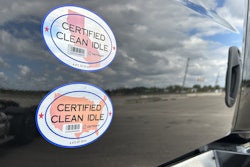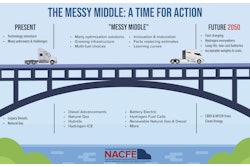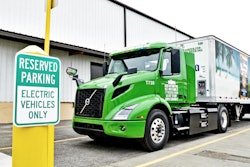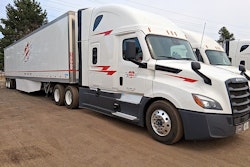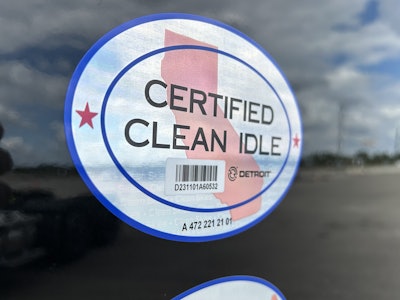
The Trump administration on Tuesday proposed a draft rule rolling back the Greenhouse Gas Phase 3 rule, among the last of – if not the biggest – looming Biden-era emissions regulations facing the trucking industry.
The proposal was announced jointly with Environmental Protection Agency Administrator (EPA) Lee Zeldin's call to revoke the Endangerment Finding that has allowed presidential administrations to regulate greenhouse gases since 2009.
“With this proposal, the Trump EPA is proposing to end 16 years of uncertainty for automakers and American consumers,” said Zeldin. “In our work so far, many stakeholders have told me that the Obama and Biden EPAs twisted the law, ignored precedent, and warped science to achieve their preferred ends and stick American families with hundreds of billions of dollars in hidden taxes every single year. We heard loud and clear the concern that EPA's GHG emissions standards themselves, not carbon dioxide which the Finding never assessed independently, was the real threat to Americans’ livelihoods."
The repeal of greenhouse gas regulations is a long road that includes a lengthy rulemaking process and likely numerous legal challenges.
Zeldin claimed rescinding the Endangerment Finding and resulting regulations would end $1 trillion or more "in hidden taxes on American businesses and families.”
The proposal, if finalized, would remove all Biden- and Obama-era greenhouse gas standards for light-, medium- and heavy-duty vehicles and heavy-duty engines, starting with EPA’s first greenhouse gas regulations set in 2010 for light-duty vehicles and those set in 2011 for medium-duty vehicles and heavy-duty vehicles and engines, which includes off-cycle credits like the start-stop feature on most new cars.
What is GHG3?
EPA in 2024 set strict emissions standards for heavy-duty trucks covering model years 2027 through 2032. The more than 1,100-page final rule called for 25% of new heavy trucks sold in the U.S. to be zero emission by 2032.
Zeldin in March announced his office would reconsider the Greenhouse Gas Emissions Standards for Heavy-Duty Vehicles – Phase 3 (GHG3) final rule, and revisit portions of the Biden-era "Clean Trucks Plan," which includes the 2022 Heavy-Duty Nitrous Oxide (NOx) rule.
RELATED: OEM emission compliance placed on customers?
Clean Freight Coalition Executive Director Jim Mullen noted the "ill-advised" GHG3 was "unattainable" and "would cause tremendous harm to the trucking industry, jeopardize the supply chain and result in higher prices for goods across our country."
The Clean Freight Coalition, American Trucking Associations and Truckload Carriers Association are among a long list of industry stakeholders who opposed GHG3 and its reliance on zero-emissions technologies that are currently both unproven and expensive.
However, Mullen added rescission of GHG Phase 3 would create opportunities for cleaner transportation by assisting "in the allocation of resources to promote the advancement and proliferation of alternative fuel sources for heavy trucks, the workhorse of our nation’s freight network.”
American Trucking Associations President and CEO Chris Spear called the GHG Phase 3 rule "disastrous" and an "electric-truck mandate [that] put the trucking industry on a path to economic ruin and would have crippled our supply chain, disrupted deliveries, and raised prices for American families and businesses."
Spear echoed Mullen and the industry's commitment to clean air, but added GHG3 "kicked innovation to the curb by discarding available technologies that can further drive down emissions at a fraction of the cost. For four decades, our industry has proven that we are committed to reducing emissions. The trucking industry supports cleaner, more efficient technologies, but we need policies rooted in real-world conditions."
Effect on equipment
Engineering has long been underway on diesel engines that will meet these now-under-fire 2027 emissions regulations. Many aftertreatment systems have been completely redesigned, electrical systems and engines re-engineered, and an entirely new diesel engine oil category has been implemented to reach compliance.
Several truck and engine OEMs told CCJ anonymously that EPA '27-compliant engines are going to be brought to market for model year 2027 with or without federal mandates. EPA's 2027 Low-NOx Rule, which is also being scrutinized, mandated redefining the "useful life" of regulated trucks from 435,000 miles to up to 650,000 miles, and it increased emissions systems warranties from 100,000 miles to up to 450,000 miles for model year 2027 trucks. The OEMs agreed that having those warranties remain at their current levels rather than increasing them under the new rule would help keep fleets' costs down on the new engines.
Likely the most certain outcome is that a 2027 model year truck pre-buy that has long been on the ropes would be completely off the table if Zeldin's proposal is finalized. Lingering poor trucking economics, tariffs and President Trump's prior repeal of California's emissions waivers had already tamped down expectations for a sales rush ahead of the 2027 model year.
President Trump in June dismantled California’s vehicle emissions standards by signing three Congressional Review Act resolutions revoking California’s waiver under the Clean Air Act. That measure, however, faces litigation.
Too, the California Air Resources Board believes the Clean Truck Partnership (CTP) it signed with all the major North American heavy truck OEMs in 2023 is legally binding, and holds truck and engine manufacturers to the standards repealed by President Trump.




